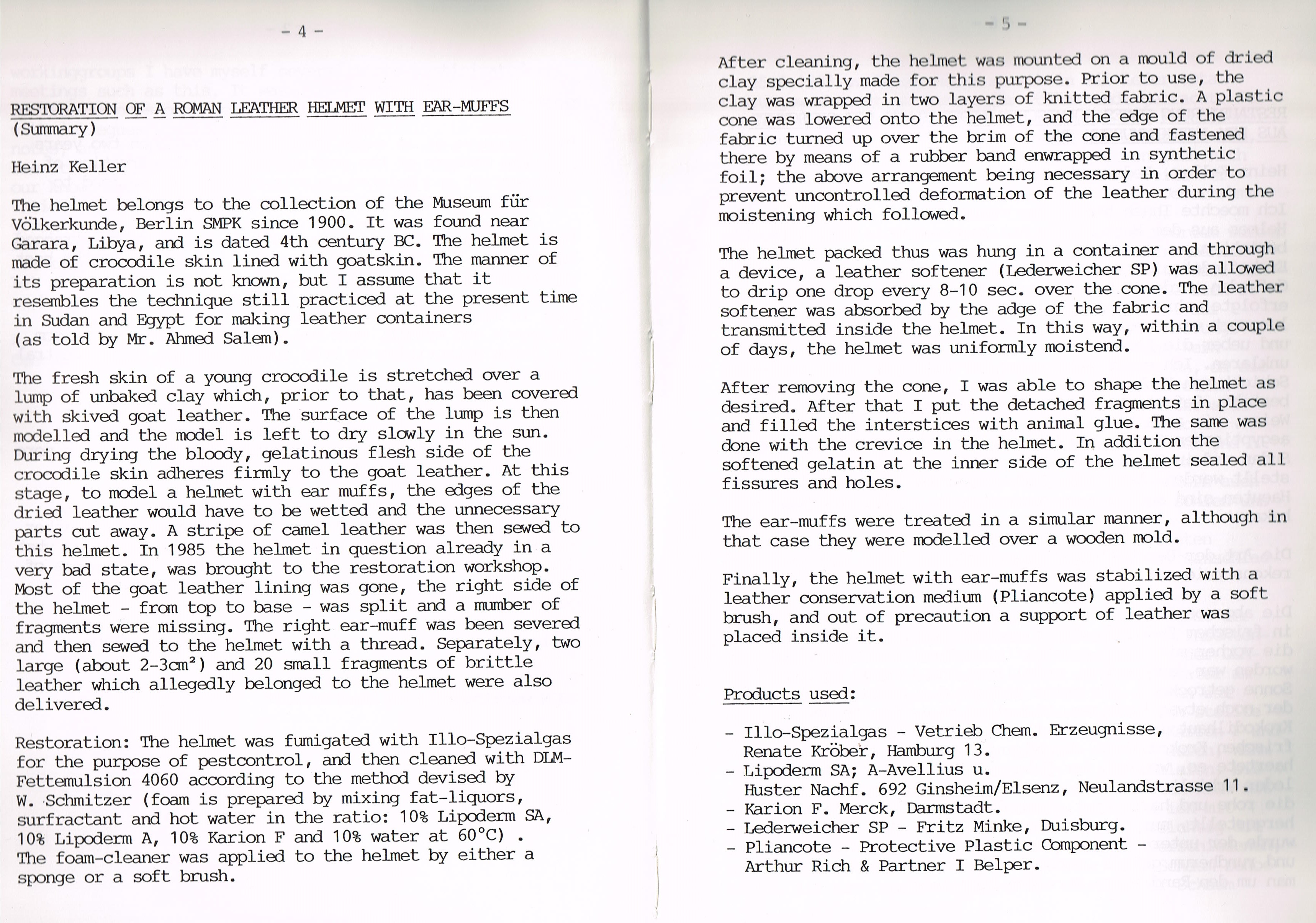CCI20140507�04

- 4 -
RESTORATION OF A ROMAN LEATHER HELMBT WITH EAR-MUFFS (Summary)
Heinz Keller
The helmet belongs to the collection of the Museum fur Volkerkunde, Berlin SMPK sińce 1900. It was found near Garara, Libya, and is dated 4th century BC. The helmet is madę of crocodile skin lined with goatskin. The manner of its preparation is not known, but I assume that it resembles the techniąue still practiced at the present time in Sudan and Egypt for making leather containers (as told by Mr. Ahmed Salem).
The fresh skin of a young crocodile is stretched over a lump of unbaked clay which, prior to that, has been covered with skived goat leather. The surface of the lump is then modelled and the model is left to dry slowly in the sun. During drying the bloody, gelatinous flesh side of the crocodile skin adheres firmly to the goat leather. At this stage, to model a helmet with ear muffs, the edges of the dried leather would have to be wetted and the unnecessary parts cut away. A stripe of camel leather was then sewed to this helmet. In 1985 the helmet in ąuestion already in a very bad state, was brought to the restoration workshop. Most of the goat leather lining was gone, the right side of the helmet - from top to base - was split and a mumber of fragments were missing. The right ear-muff was been severed and then sewed to the helmet with a thread. Separately, two large (about 2-3cm2) and 20 smali fragments of brittle leather which allegedly belonged to the helmet were also delivered.
Restoration: The helmet was fumigated with Illo-Spezialgas for the purpose of pestcontrol, and then cleaned with DLM-Fettemulsion 4060 according to the method devised by W. Schmitzer (foam is prepared by mixing fat-liquors, surfractant and hot water in the ratio: 10% Lipoderm SA,
10% Lipoderm A, 10% Karion F and 10% water at 60°C) .
The foam-cleaner was applied to the helmet by either a sponge or a soft brush.
After cleaning, the helmet was mounted on a mould of dried clay specially madę for this purpose. Prior to use, the clay was wrapped in two layers of knitted fabric. A plastic cone was lowered onto the helmet, and the edge of the fabric tumed up over the brim of the cone and fastened there by means of a rubber band enwrapped in synthetic foil; the above arrangement being necessary in order to prevent uncontrolled deformation of the leather during the moistening which followed.
The helmet packed thus was hung in a Container and through a device, a leather softener (Lederweicher SP) was allowed to drip one drop every 8-10 sec. over the cone. The leather softener was absorbed by the adge of the fabric and transmitted inside the helmet. In this way, within a couple of days, the helmet was uniformly moistend.
After removing the cone, I was able to shape the helmet as desired. After that I put the detached fragments in place and filled the interstices with animal glue. The same was done with the crevice in the helmet. In addition the softened gelatin at the inner side of the helmet sealed all fissures and holes.
The ear-muffs were treated in a simular manner, although in that case they were modelled over a wooden mold.
Finally, the helmet with ear-muffs was stabilized with a leather conservation medium (Pliancote) applied by a soft brush, and out of precaution a support of leather was placed inside it.
Products used:
- Illo-Spezialgas - Vetrieb Chem. Erzeugnisse,
Renate Króber, Hamburg 13.
- Lipoderm SA; A-Avellius u.
Huster Nachf. 692 Ginsheim/Elsenz, Neulandstrasse 11.
- Karion F. Merck, Darmstadt.
- Lederweicher SP - Fritz Minkę, Duisburg.
- Pliancote - Protective Plastic Gomponent -Arthur Rich & Partner I Belper.
Wyszukiwarka
Podobne podstrony:
BARCELONAInterested in ex vivo validation of your PET results with multilabel capabilities ?Com
CCI20140507�24 -42- Infra-Red-Spectrophotometric amlysis and ocmparison with sanple of Roman finds a
CCI20140507�07 -10- -10- Ranan leather helmet of the 14th century BC. TIIK DIOCKKAHING OK A SKT OK G
CCI20140507�09 -40- ROMAN LEATHER FINDS EROM MAINZ (Summary) Jutta Gdpfrich Excavation In 1982-3 the
screenshot 006 restore partition frorn image file Options [f ] Sinulation of the restoration (noth [
00071 ?e586b9e4c806e780db8de67c99d012 70 Hembree & Zimmer To test the DBAF, two time senes of f
00175 Sf44c966c95fb915bf72191bd27e4aa 176 McWilliams To understand the wide rangę of cost penalties
00225 ?49267320ac3d7851e1017e71c81bec 227 Applications of the EWMA Figurę 6. Esample of Modified Sh
00243 qeba09294a7c4e7be519dcac12e96db Statistical Process Monitoring with Integrated Moving Average
00362 ?925c9a2744b1032ec4f0949c79ed90 366 Obenchain poor-quality, or a measure of customer/regulato
in-circuit checks: ** Ouality of over 80% of alt condensers evcn with Circuit shunt resistance . ..
241Occupational Injuries and Infccfions A survcy of meat handlers affected with skiti scusis in Nort
An important number of intemational institutions deals with Production Engineering problems, i.e. Th
GRUBER PROPERTIES THE N E XT L E V E LThis deve!opment in Pretoria comprises of an Office błock with
S5006699 210 Heine Dotnahrtm end Jen nekeruj* employed to the producSon of Roman period poOery. base
więcej podobnych podstron